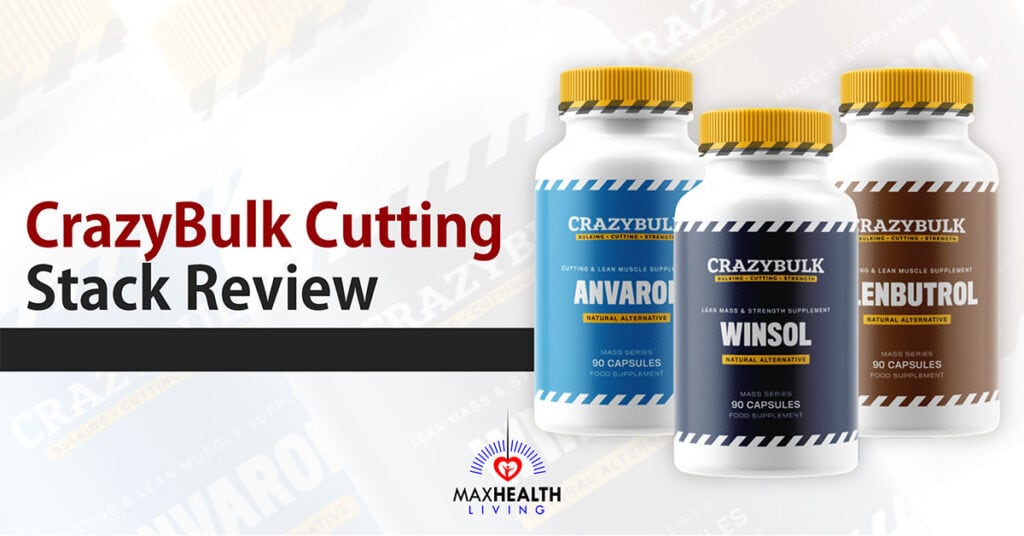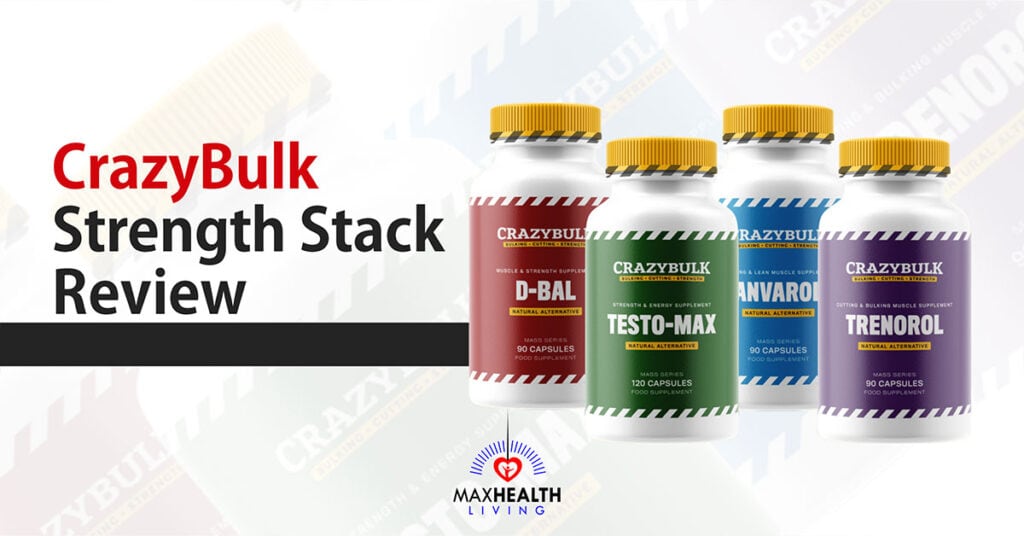Is Bench Press Enough For Chest? (upper & lower)
Max Health Living is a reader-supported site. Purchases made through links may earn a commission. Learn more.
Is bench press enough for a chest, or is it an exercise that runs on hype and convention?
Today we’re going to ask if you can build a big chest with just a bench press and what else might be used to get the most from this all-time favorite upper body movement.
Let’s get started with the chest – how does it work, and what does that mean for your bench press?
The Chest muscles: Basics
The chest is broad of the pectoralis major and minor. These two muscle groups are the basic unit we use to define the chest muscles.
The pec major is the big, visible muscles on a bodybuilder or athlete that vaguely join the collarbone, shoulders, and sternum.
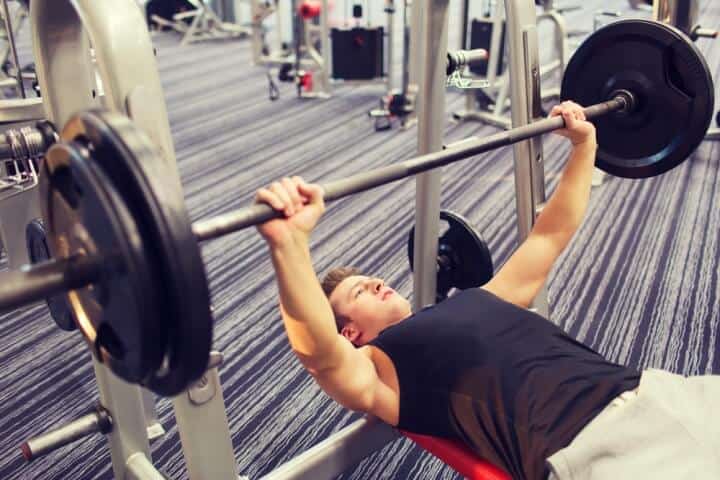
These are popular muscles to train and develop because they’re very obvious. They’re the silhouetting muscles for a t-shirt, they provide some of the V-taper that makes men look athletic, and they begin to fill out the upper body along with the delts, lats, and upper arms.
Chest muscles are also important for a range of exercises and movements. They’re a priority for things like gymnastics, swimming, and even rugby, as key contributors to strong upper body movement.
Anatomy stuff
The pec major is split into two muscle ‘heads.’
The clavicular head is the chest’s upper portion, and the sternal head is the lower portion. Broadly, the clavicular (upper) pec major works with the shoulders when the arm is at a high angle – at or above the shoulder’s height.
On the other hand, the sternal head is more involved when the arm is at a lower angle – at or below the height of the shoulder joint.
This makes the clavicular head more closely isolated on the n incline bench and the sternal head in the decline bench press, dips, or the half-planche push-up.
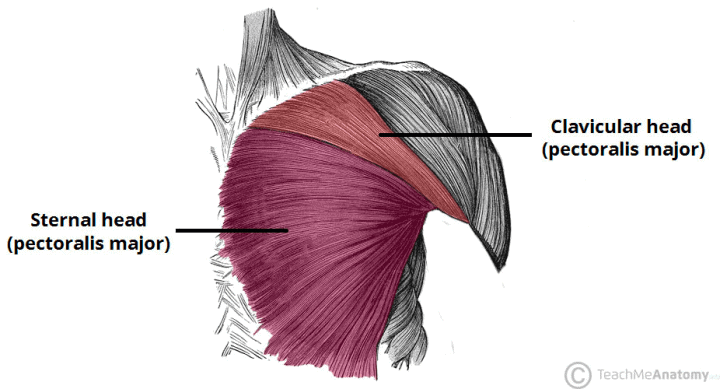
A good chest-building workout routine should use both of these muscles effectively. The combination of different angles will also be important for how the relationship between the chest and front delt and the triceps develops.
The chest will develop most with both heads receiving combined attention and then isolated attention.
The flat bench is often used for its ability to develop both heads and then followed with specific incline and decline bench press variations to target them individually.
For most men, the sternal head is an important area of development for more defined lower pec silhouettes. This produces a firmer appearance and reduces the ‘man boob’ appearance with lower body fat percentages.
The clavicular head is an important muscle for military press and other overhead exercises.
The Pec Minor: An Important Chest Muscle
You also have a pectoralis minor muscle that is part of the chest – though this receives far less attention from most people. It’s a muscle that is crucially important to develop while you’re building the pec major, as this prevents weakness and injury risk – which could ruin your chest gains momentum.
The pec minor receives less attention because it is underneath the pec major and is mostly involved in pulling the shoulders towards the ribcage (forward and down).
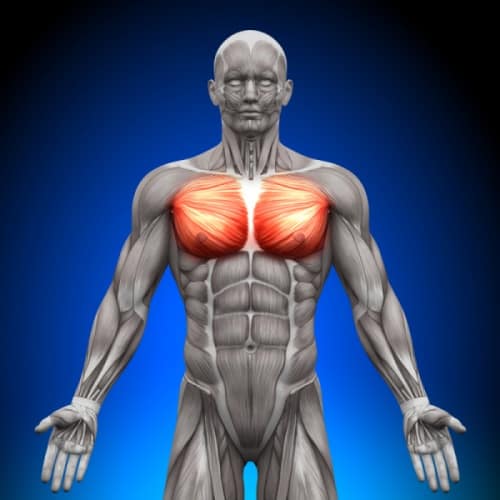
This is involved in lighter exercises than the bench press, where the shoulder needs to move relative to the body – an end-range position for push-ups and dips (e.g.) that make it important to train more than just the bench press.
The pec minor needs to develop through a long-range exercise involving full shoulder and chest movement.
It’s an important muscle to remember when you develop a chest workout routine, with ‘smaller’ exercises like flyes, push-ups, and holds being crucially important.
Is Bench Press Enough for Chest?
Yes – the bench press is enough for building a chest, but it’s not the best approach to building a great chest. It’s a conventional exercise often used to build the chest because it’s the most effective and easiest way to build a chest while also training the shoulders and triceps effectively.
The bench press is the most popular form of chest exercise and the main upper body exercise used to build and test pressing strength.
It’s a “big” compound exercise that makes it easier to load progressively than ” smaller ” exercises with less total muscle. This makes the bench press a time-efficient exercise and a good measure of strength for most people.
This is the important part: bench press is enough to build the chest, but you could make more gains in less time by combining it with other exercises.
You don’t need other chest exercises, they will help you get the best results from your time in the gym.
The Problem With Only Bench Pressing for Chest Growth
There are two major problems with only using the bench press to build the chest:
- You will limit your chest development
- You’ll limit your bench press development
If you don’t do anything other than the bench, you’ll limit your ability to grow and then limit your bench press development. This can lead to early and stubborn plateaus.
This is why intermediate and advanced powerlifters use a variety of accessory exercises for the chest.
You’ll want to – at least – vary how you train your bench press. For example, you could use a flat bench as your main bench press but vary with an incline bench press and dumbbell bench press on other days to help maintain growth and strength-development over time.
This variety is often more important than progressive overload through reps and weights.
You need to be willing to adjust – even small ones – to your exercises over the long run to build a bigger chest and a bigger bench press!
Bench Press for Chest FAQs
Do you need to bench for chest muscles?
No – you don’t need to bench press to build a big chest.
It’s simply one of the most effective and efficient ways to do so, as you’ll typically spend less time in the gym due to the heavy weights you can use in the bench press and the fact it’s a compound exercise. It trains the chest, but also the front delts and the triceps.
The bench press is a popular exercise for building the chest, but it isn’t necessary.
You can also use things like the chest flye – as well as its variations – as well as pullovers. Other options include dips, arguably better for chest development than a bench press, and ring push-ups.
These are all good options. It is typically useful to do some form of bench press while building the chest, even if that’s a bench press variation or similar.
How much do I have to bench for a big chest?
No specific amount of bench press strength will guarantee a big chest.
You don’t even need to bench for a big chest – it’s just a popular and convenient option that can be used to strengthen all of your pushing muscles.
Some people will have large chests without performing any bench press, so there’s no specific weight requirement. Equally, some people with very strong bench press numbers do not have very large chests.
You should bench more. Focus on progressing the exercise and using a technique that keeps you safe and targets the chest muscles. Then, focus on adding other high-quality chest exercises like dips, offset push-ups, and chest flyes (with cables, e.g.) to build a bigger chest.
Is bench press enough for triceps?
Yes, the bench press will build bigger triceps by itself. However, it’s still not optimal for building triceps, just like it’s not optimal to bench press for the chest.
Adding other exercises that isolate the tricep is important to build all three heads of the triceps and achieve the best muscle growth.
The long head of the tricep is particularly important here, as it requires more external rotation than the others. This is often lacking in the bench press and is best developed with long, stretch-mediated exercises such as the overhead tricep extension, lying dumbbell skull crushers, or tricep extension.
Bench pressing can be the foundation for bigger triceps – especially narrower grips or dumbbell variations – but shouldn’t be your only tool.
It will work if it’s the only one you can do, but it’s not optimal.
Is bench press good for you?
The bench press is good for you as it builds the strength and muscle mass needed to keep the pushing motions of the upper body strength. This is an important way to develop the body and keep the shoulders, elbows, and wrists strong.
The bench press can be bad for you if it is done at the cost of proper exercise balance – or if used to excess.
The bench press is good for you unless it causes injuries or other problems. Noticeably, the forward-binding of the shoulder girdle is often seen in people who do lots of bench press but never address the other shoulder movements.
Make sure your bench press is also trained with other shoulder movements: rows, pull-ups, reverse flyes, dips, shrugs, and other forms of shoulder and scapular movement.
These will help keep you strong in all three dimensions and prevent over-biasing towards a single movement, which is never a good idea.
Is bench press effective for the chest?
Yes – the bench press is a chest exercise with natural strength and muscle mass benefits the pec major and pec minor. It also builds the front delts and triceps, making it an efficient way to build the upper body’s silhouetting muscles and push strength.
Some forms of the bench press – particularly with dumbbells – are better for building the chest.
Others, like the close grip bench press, are worse for building the chest as they focus more on the triceps (and others still on the shoulders).
You can use the bench press as a major exercise to build the chest, but it works best when combined with other exercises that stretch the chest muscles through their full range of motion. These include full-range dips, full-range ring push-ups, and chest flyes with dumbbells or cables.
Should you bench heavy to get a bigger chest?
You can bench heavy to get a bigger chest. You should bench moderately heavy for more reps and with a wider variety of secondary and accessory exercises.
As with all muscles, a combination of regularity (for adding weight) and variety (for adding new stimulus) is the sweet spot.
You should bench heavy 1-2 times a week while focusing the rest of your exercises on weak spots, especially long-range movements with lighter weights. These are important for building muscle in the chest and strength in the full ranges to prevent injury and stagnation.
Benching heavy is the most dependable platform for building a big chest, but it’s not the most effective approach.
Add more reps from other exercises. You can develop the most chest muscle with the least time invested.
What’s the best bench press for chest muscles?
The best bench press for the chest muscles is probably the decline dumbbell bench press with a pause at the bottom.
This combines all the best benefits of the decline bench press with the stability and chest-focus of the dumbbell bench press. The pause adds a stretch stimulus, producing the best muscle and strength results.
The normal paused dumbbell bench press and non-paused versions are also excellent. These strengthen the chest to its full range and force you to stabilize the weights laterally, which the barbell variation doesn’t require.
The decline bench press and the Spoto press are great options with a barbell, where you will focus more on using the chest.
The Spoto press, in particular, can be a great high-rep exercise to develop strength, control, and muscle mass simultaneously.
Conclusion
A bench press is enough to build a chest – but not the best choice. It’s the foundation that you should use to add accessories to as a way to improve your strength and chest muscle mass significantly.
There’s no 1-1 connection between the strength and size. It can be a real limitation to only bench press.
The bench press is a great way to build a chest if you have no alternative. If you add variety to that mixture, you’re on your way to optimal chest growth.
Be willing to mix and match, and remember that your bench press needs its variety, by load, by weight, and by variation, to get the best results. Even switching to an incline bench or dumbbell bench can make a huge difference in beating plateaus and stimulating new, sustainable growth.
Important Disclaimer: The information contained on MAX HEALTH LIVING is intended for informational and educational purposes only. Any statements made on this website have not been evaluated by the FDA and any information or products discussed are not intended to diagnose, cure, treat, or prevent any disease or illness. Please consult a healthcare practitioner before making changes to your diet or taking supplements that may interfere with medications.
Who We Are

We are a team of fitness, health, and supplement experts, and content creators. Over the past 4 years, we have spent over 123,000 hours researching food supplements, meal shakes, weight loss, and healthy living. Our aim is to educate people about their effects, benefits, and how to achieve a maximum healthy lifestyle. Read more.


